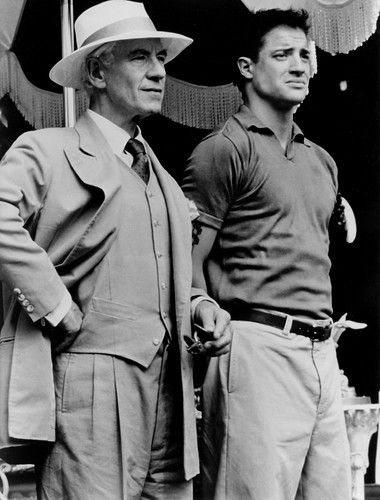
Vintage press photo. Ian McKellen as James Whale and Brendan Fraser in Gods and Monsters (Bill Condon, 1998).
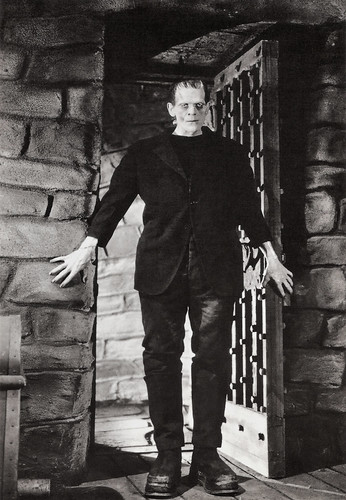
American postcard by Classico San Francisco, no. 233/01. Photo: Universal Pictures. Boris Karloff in Frankenstein (James Whale, 1931).

British postcard in the Filmshots series by Film Weekly. Photo: Universal. Gloria Stuart and Claude Rains in The Invisible Man (James Whale, 1933).
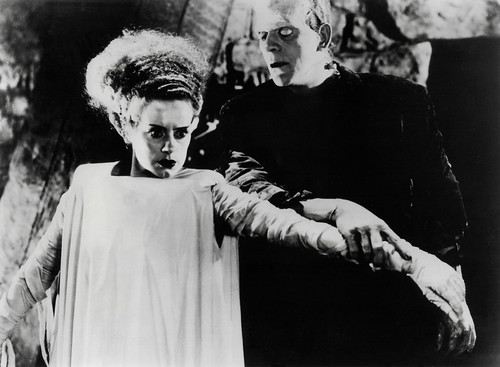
Dutch press photo. Elsa Lanchester and Boris Karloff in Bride of Frankenstein (James Whale, 1935).

British postcard in the Film Partners Series, London, no. P. 306. Photo: Edward Small Prod. Louis Hayward and Joan Bennett in The Man in the Iron Mask (James Whale, 1939).
Journey's End
James Whale was born in Dudley, England in 1889. He was the sixth of seven children of blast furnace worker William Whale and his wife Sarah, a nurse. While his childhood in the West Midlands was characterised by the family's poverty, he decided not to become a worker in the local heavy industry like his brothers. He had to leave school at the age of thirteen to work. Juggling odd jobs, he gradually discovered a passion for drawing and painting and found work as a cartoonist for The Bystander magazine.
The First World War broke out when he was not yet 25. He joined the army and was taken prisoner of war as a non-commissioned officer in 1917. Imprisoned in a camp, he discovered his passion for theatre. The experience was a revelation for him. After a few attempts as an actor, he began a career as a set designer for the theatre. However, it was not until he was 40 that he had his first opportunity to direct a play.
In 1928 Whale got the chance to direct two private performances of R. C. Sherriff's then-unknown anti-war play 'Journey's End' for the Incorporated Stage Society, a theatre society that mounted private Sunday performances of plays. Set over four days in March 1918 in the trenches at Saint-Quentin, France, 'Journey's End' gives a glimpse into the experiences of the officers of a British infantry company in World War I. The key conflict is between Captain Stanhope, the company commander, and Lieutenant Raleigh, the brother of Stanhope's fiancée. Whale offered the part of Stanhope to the then-barely-known Laurence Olivier. Olivier initially declined the role, but after meeting the playwright agreed to take it on. Maurice Evans was cast as Raleigh.
The play was well received and transferred to the Savoy Theatre in London's West End, opening on 21 January 1929. Colin Clive was now in the lead role, Olivier having accepted an offer to take the lead in a production of 'Beau Geste'. 'Journey's End' was a tremendous success, with critics uniform and effusive in their praise and with audiences sometimes sitting in stunned silence following its conclusion only to burst into thunderous ovations. The play had more than 500 performances. In the same year, Whale directed and designed the set for the plays 'Fortunato and the Lady from Alfaqueque' and 'The Dreamers' with John Gielgud, before being invited to stage 'Journey's End' on Broadway in 1929. The play was also successful in the USA and Whale made the leap to film as a dialogue director for The Love Doctor (Melville W. Brown, 1929) starring Richard Dix. He went on to direct the stage productions of R. C. Sherriff's ‘Badger's Green’ and the two one-act plays ‘The Violet’ and ‘One Two Three’ by Ferenc Molnár.
Whale was also responsible as a dialogue director for some of the interior shots of Howard Hughes' World War I aerial drama Hell's Angels (1930) with Jean Harlow, which cost 3.95 million US dollars at the time. Having purchased the film rights to 'Journey's End', British producers Michael Balcon and Thomas Welsh agreed that Whale's experience directing the London and Broadway productions of the play made him the best choice to direct the film. The two partnered with a small American studio, Tiffany-Stahl, to shoot it in New York. Colin Clive reprised his role as Stanhope, and David Manners was cast as Raleigh. On both sides of the Atlantic Journey’s End (James Whale, 1930) was a tremendous critical and commercial success. As Whale biographer James Curtis wrote, Journey’s End "managed to coalesce, at the right time and in the right manner, the impressions of a whole generation of men who were in the war and who had found it impossible, through words or deeds, to adequately express to their friends and families what the trenches had been like."
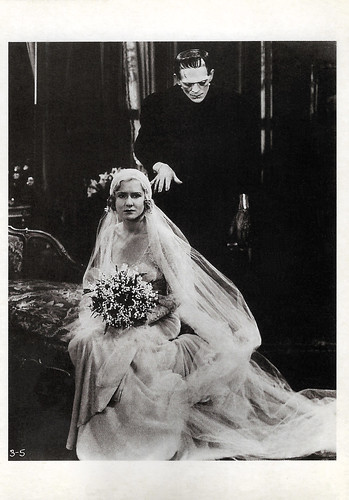
American postcard by American Postcard, no. 38. Boris Karloff and Mae Clarke in Frankenstein (James Whale, 1931).
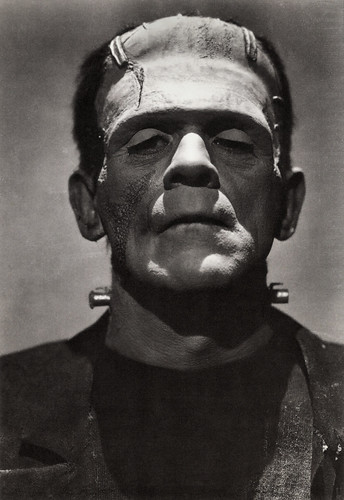
American postcard by Classico San Francisco, no. 233/06. Photo: Roman Freulich / Universal Pictures. Boris Karloff in Frankenstein (James Whale, 1931).

American postcard by Zoetrope Images Ltd., Boston, no 432. Photo: Boris Karloff in Frankenstein (James Whale, 1931).
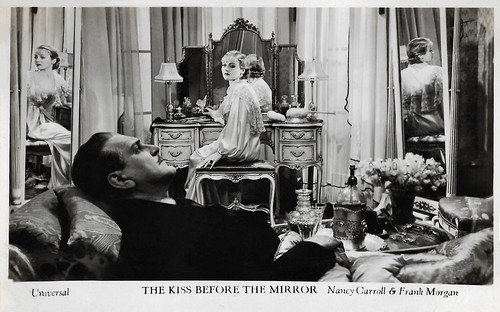
British postcard in the Film Weekly series. Photo: Universal. Nancy Carroll and Frank Morgan in The Kiss Before the Mirror (James Whale, 1932).
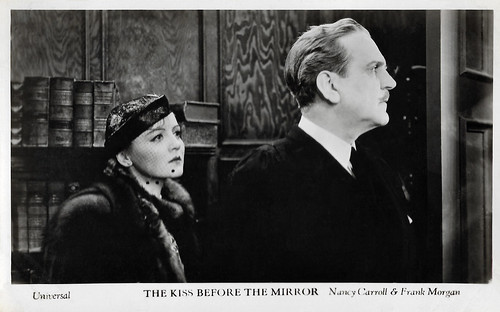
British postcard in the Film Weekly series. Photo: Universal. Nancy Carroll and Frank Morgan in The Kiss Before the Mirror (James Whale, 1932).
Frankenstein
In 1931, Universal Pictures signed James Whale to a five-year contract. His first project was Waterloo Bridge (1931) starring Mae Clarke and Douglass Montgomery. It is the first film adaptation of Robert E. Sherwood's play of the same name. The film tells the story of a tragic romance between a Canadian soldier who falls in love with an English woman during his stay in London, unaware that she is a prostitute. It was another critical and popular success.
Universal chief Carl Laemmle Jr. then offered Whale his choice of any property the studio owned. Whale chose Frankenstein (1931). Following the success of Dracula (Todd Browning, 1930), Universal had commissioned French director Robert Florey to write a screenplay for Mary Shelley's novel 'Frankenstein or the Modern Prometheus'. However, the sequences directed by Florey were not to the studio’s liking and Universal decided that James Whale was to direct. Whale insisted that Colin Clive be given the part of Dr Frankenstein and he cast Mae Clarke as his fiancée Elizabeth. Whale gave the role of the monster, for which the Dracula actor Bela Lugosi had originally been in discussion, to the little-known 42-year-old British theatre and film actor Boris Karloff, who had a wide-ranging experience in supporting roles.
The production, estimated at 291,000 US dollars, made a huge profit and is still considered one of the most important Horror films to this day. Frankenstein (1931) made Boris Karloff a star overnight and James Whale one of Universal Studios' leading directors. Universal insisted on entrusting Whale with further Horror films. After the drama Impatient Maiden (1931), Whale directed the Horror film The Old Dark (1932), based on a novel by John Boynton Priestley. Boris Karloff played the lead role of a bestial servant who terrifies a group of travellers in a Welsh country house.
The mystery The Kiss Before the Mirror (1932), starring Nancy Carroll, Frank Morgan, Paul Lukas and Gloria Stuart, was a critical success but a box-office failure and was followed by The Invisible Man (1933). In this film adaptation of a novel by H. G. Wells, Claude Rains plays a scientist who mutates into an invisible, insane murderer thanks to a formula he has developed. Shot from a script approved by Wells, the film blended horror with humour and confounding visual effects. It was critically acclaimed, with The New York Times listing it as one of the ten best films of the year, and it broke box-office records in cities across America. That same year, Whale directed the delicious romantic comedy By Candlelight (1933) with Elissa Landi and Paul Lukas. In 1934 he directed One More River, an adaptation of the novel of the same name by John Galsworthy. The film tells the story of a woman desperate to escape her abusive marriage to a member of the British aristocracy.
With the sequel Bride of Frankenstein (1935), in which Elsa Lanchester plays the title role alongside Boris Karloff, Whale maintained his reputation as one of the most important directors of the Horror genre. Bride is frequently hailed as Whale's masterpiece and one of the best Gothic Horror films ever. Whale then adapted the novel 'The Hangover Murders', a comedy mystery in the style of 'The Thin Man', about a group of friends who were so drunk the night one of them was murdered that none can remember anything. Retitled Remember Last Night? (1935), the film was one of Whale's personal favourites. Then followed another of the director’s favourites, Show Boat (1936), a graceful adaptation of Oscar Hammerstein's musical of the same name with Irene Dunne and Paul Robeson. It was the last of Whale's films to be produced under the Laemmle family.
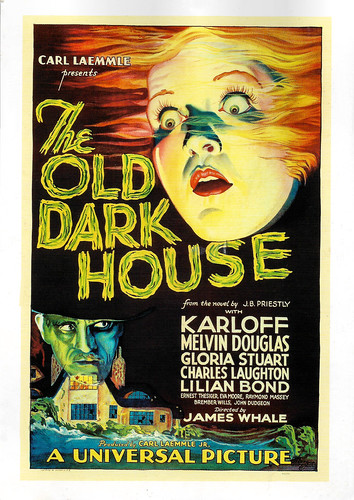
American postcard by The Museum of Modern Art, New York, N.Y., 2001. American poster by Universal for The Old Dark House (James Whale, 1932).

British postcard in the Filmshots series by Film Weekly. Photo: Universal. Claude Rains and William Harrigan in The Invisible Man (James Whale, 1933).
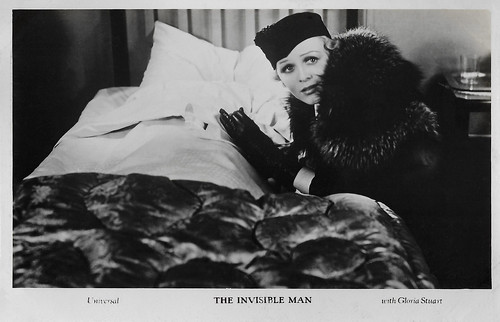
British postcard in the Filmshots series by Film Weekly. Photo: Universal. Gloria Stuart (and Claude Rains) in The Invisible Man (James Whale, 1933).

British postcard in the Film Shots series by Film Weekly. Photo: Universal. Paul Lukas and Elissa Landi in By Candlelight (James Whale, 1933).
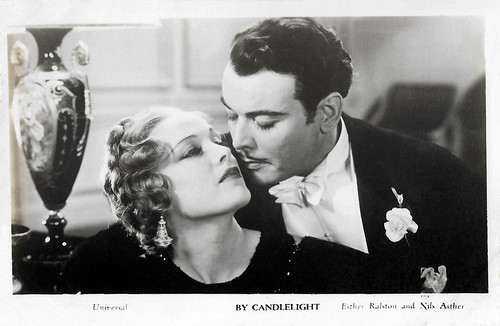
British postcard in the Film Shots series by Film Weekly. Photo: Universal. Nils Asther and Esther Ralston in By Candlelight (James Whale, 1933).

British postcard in the Film Shots series by Film Weekly. Photo: Universal. Nils Asther, Paul Lukas and Esther Ralston in By Candlelight (James Whale, 1933).
The Road Back
The management at Universal Pictures changed due to financial problems. Although the film studio managed to stave off bankruptcy, the director and founder of Universal, Carl Laemmle and his son, Carl Laemmle, Jr., who had always given James Whale a free hand with his films, were forced to resign and the Standard Capital Company took over Universal. In production was the war drama The Road Back, a sequel to its successful predecessor All Quiet on the Western Front (Lewis Milestone, 1930) and based on Erich Maria Remarque's follow-up novel ‘Der Weg zurück’. Combining a strong anti-war message with prescient warnings about the rising dangers of the dictatorship of Nazi Germany, it was intended to be a powerful and controversial picture, and Universal had entrusted it to their finest director, James Whale.
The film was already heavily criticised during production by the Los Angeles consul for Nazi Germany, Georg Gyssling, for its anti-German tendencies. In fact, Whale had adopted the strong anti-Nazi tone of the novel for the adaptation. Whale's original cut of the film was given generally positive reviews, but sometime between preview screenings and the film's general release, the new studio boss Charles Rogers capitulated to the Germans, ordering that cuts be made. He ordered writer Charles Kenyon to interject the script with comedy scenes between Andy Devine and Slim Summerville. Whale was furious about the result, and the altered film was banned in Germany anyway. The Germans were successful in persuading China, Greece, Italy and Switzerland to ban the film as well.
For James Whale, The Road Back (1937) was the last major production he directed. Charles Rogers tried to get out of his contract with Whale, but Whale refused. Disgusted with the studio's cowardice under its new management, Whale only completed Wives Under Suspicion (1938), an unsuccessful remake of his own film The Kiss Before the Mirror (1932). Whale was loaned out to rival film studios Warner Bros. and MGM, for whom he made the romantic comedy The Great Garrick (1937) with Olivia de Havilland and Brian Aherne and the drama Port of Seven Seas (1938) a screen adaptation of Marcel Pagnol's classic play ‘Fanny’ with Wallace Beery and Frank Morgan.
Whale's career and reputation had declined considerably by the end of the 1930s, but he was still more than enough of a highly skilled craftsman to helm the independent production The Man in the Iron Mask (1939). Bruce Eder at AllMovie: "Producer Edward Small didn't have the kind of money that MGM would have been able to put into a swashbuckler of this sort, but Whale had enough talent to make it look like he did. His clever and graceful camera moves (especially those dolly-shots) make the sets look twice as big and lavish as they ought to have, and his eye for characters and close-ups lends this movie a good level of emotional intensity, helped not a little bit by Louis Hayward's successful portrayal of a pair of identical (but emotionally and morally very different) twins. Joan Bennett's Infanta of Spain is not quite as central to the action as one would expect of the leading lady, but she makes the most of her scenes."
Whale's last film for Universal was the adventure film Green Hell (1940) with Douglas Fairbanks Jr. and Joan Bennett. Whale never completed his twentieth and final feature film, They Dare Not Love (1941), about an Austrian prince who flees into exile from the National Socialists and decides to fight against the regime. The film studio Columbia Pictures replaced him with Charles Vidor and only contractual clauses preserved the filmmaker's name in the credits. With the outbreak of World War II, Whale volunteered his services to make a training film for the United States Army. He shot the film, called Personnel Placement in the Army, in February 1942.

British postcard in the Film Shots series by Film Weekly. Photo: Universal. Paul Lukas and Elissa Landi in By Candlelight (James Whale, 1933).

French postcard in the Entr'acte series by Editions aphodèle mâcon, no 001/09. Photo: Boris Karloff relaxing with a cigarette during an interval of the shooting of The Bride of Frankenstein (James Whale, 1935).
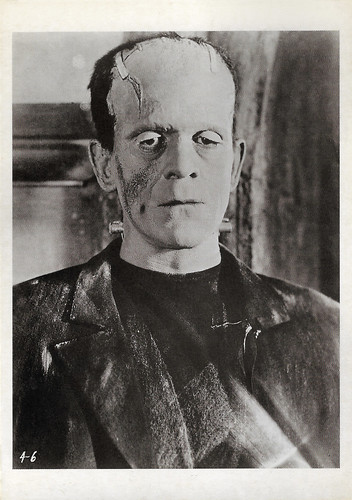
American postcard by American Postcard, no. 36. Boris Karloff in Bride of Frankenstein (James Whale, 1935).
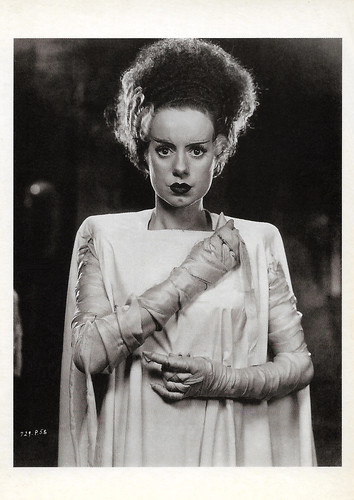
American postcard by American Postcard, no. 41. Elsa Lanchester in Bride of Frankenstein (James Whale, 1935).
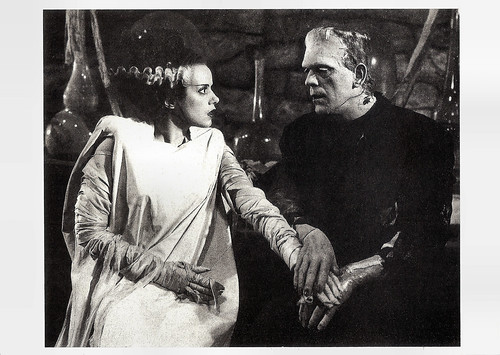
French postcard in the Collection Cinéma by Editions La Malibran, Paris, no. CA 53, 1989. Photo: Boris Karloff and Elsa Lanchester in Bride of Frankenstein (James Whale, 1935).
Gods and Monsters
After the end of his film career, James Whale returned to Broadway in 1944, where he directed the psychological thriller 'Hand in Glove' for the Playhouse Theatre. It was not a success.
In 1949, he took his last seat in the director's chair and made the 41-minute short film Hello Out There, based on a William Saroyan one-act play. It was the story of a man in a Texas jail falsely accused of rape and the woman who cleans the jail. The short was intended to be part of an anthology film for RKO along the lines of Quartet (Ken Annakin, a.o., 1948). The film was produced by the American supermarket heir Huntington Hartford to make his then-wife, the actress Marjorie Steele, better known. However, Hartford was unhappy with the result and Hello Out There (1949), made for 41,000 US dollars on a single set at KTTV Studios in Los Angeles, was never commercially released.
Whale's last work as a theatre director was the production of the play 'Pagan in the Parlour' at the Pasadena Playhouse. The play, a farce about two New England spinster sisters who are visited by a Polynesian whom their father, when shipwrecked years earlier, had married, was also performed briefly in England. In Europe, Whale rediscovered his love for painting and travel. His investments had made him wealthy and he lived a comfortable retirement until suffering strokes in 1956 that robbed him of his vigour and left him in pain.
Rumours of homosexuality had always accompanied the formerly celebrated film director. He actually lived openly with his partner David Lewis, an American film producer. After the strokes, Whale suffered from loneliness and depression and drowned in his swimming pool in Santa Monica in 1957 at the age of 67. The circumstances of his death remained a mystery until David Lewis confirmed the rumours of suicide years later. Lewis had found Whale dead, as well as a farewell note that was first printed in James Curtis' biography in 1982. It read "The future is just old age and illness and pain... I must have peace and this is the only way." Whale was buried in the Forest Lawn Memorial Park Cemetery in Glendale, California.
In 1997, the last phase of James Whale's life was made into a film based on the novel 'Father of Frankenstein' (1995) by Christopher Bram. Film and theatre actor Ian McKellen starred as Whale in Gods and Monsters (Bill Condon, 1997) with Brendan Fraser as the fictional gardener Clayton Boone, whom he hired and fell in love with. McKellen was nominated for an Oscar and a Golden Globe for Best Actor in a Leading Role in 1999. In 2002, a memorial statue in the form of a film reel was erected in front of a new multiplex cinema in James Whale's birthplace Dudley.
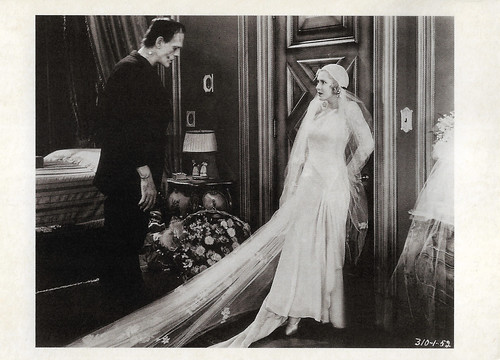
American postcard by American Postcard, no. 37. Boris Karloff and Mae Clarke in Frankenstein (James Whale, 1931).
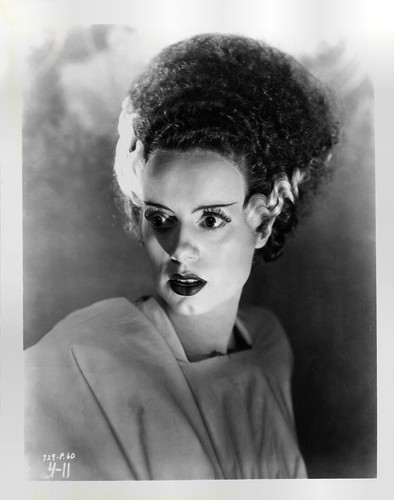
Vintage press photo. Elsa Lanchester in Bride of Frankenstein (James Whale, 1935).
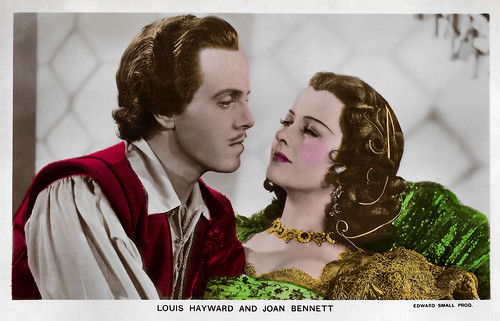
British postcard in the Film Partners Series, London, no. P. 306. Photo: Edward Small Prod. Louis Hayward and Joan Bennett in The Man in the Iron Mask (James Whale, 1939).

Vintage press photo. Ian McKellen and Rosalind Ayres in Gods and Monsters (Bill Condon, 1998).
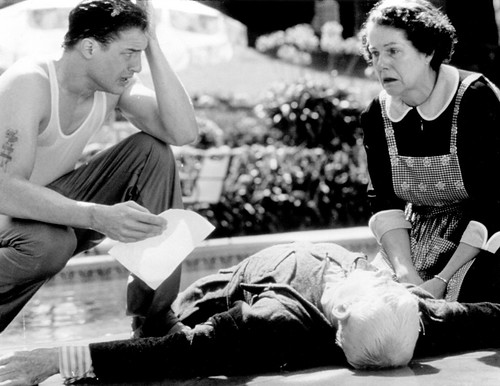
Vintage press photo. Brendan Fraser, Ian McKellen and Lynn Redgrave in Gods and Monsters (Bill Condon, 1998).
Sources: James Curtis (James Whale), ;Bruce Eder (AllMovie), Pedro Borges (IMDb), AllMovie, Wikipedia (Dutch, German, French and English) and IMDb.
No comments:
Post a Comment